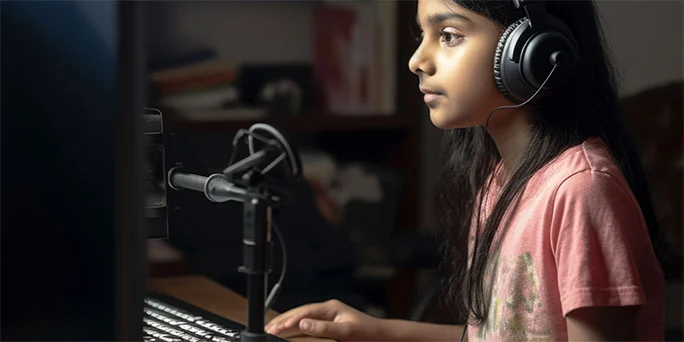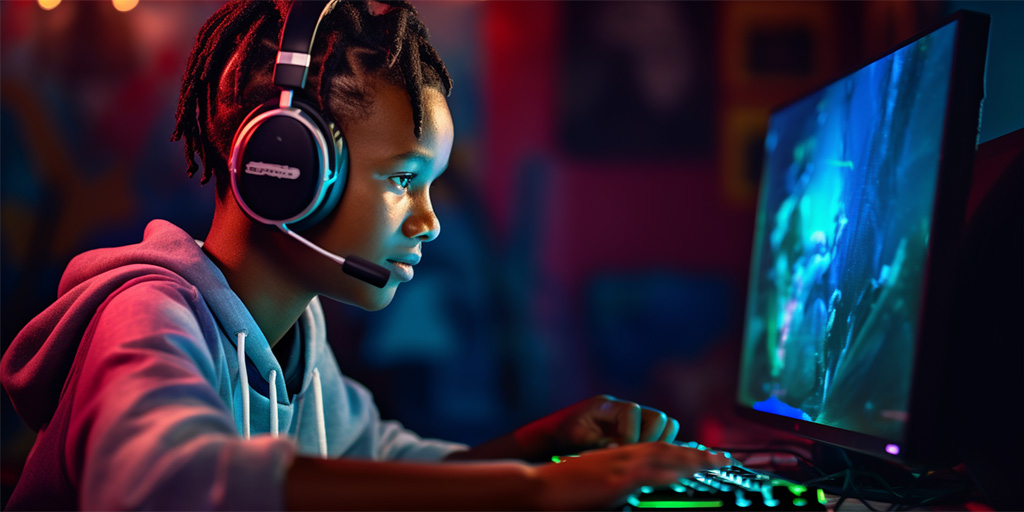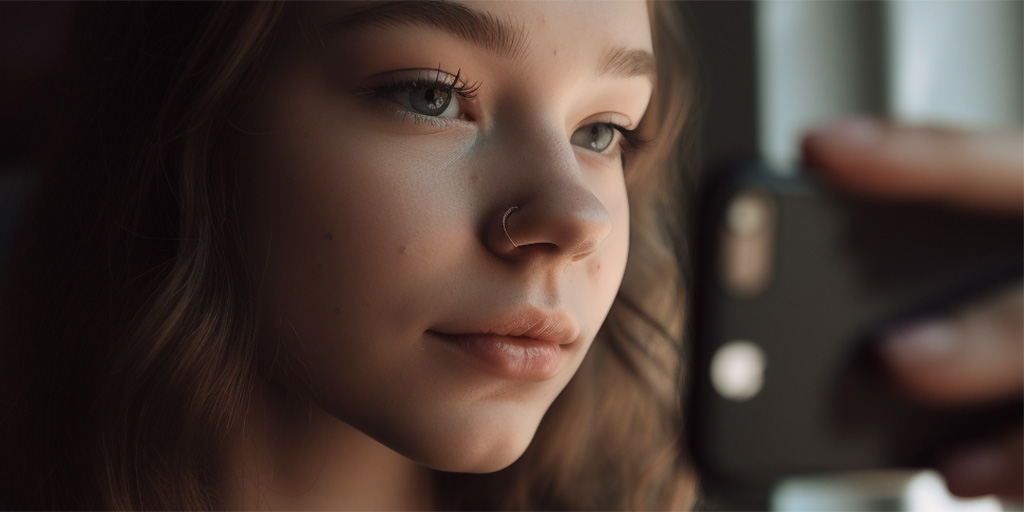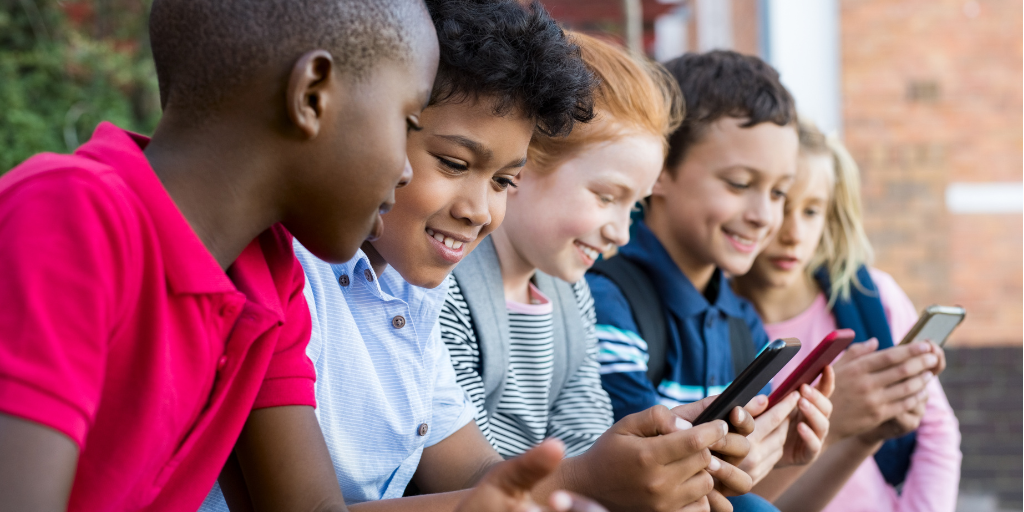
What do kids today aged 8-12 want to be when they grow up? According to a 2019 Harris / LEGO poll, it's a “YouTuber” (the nickname for content creators on YouTube), by a country mile. And many kids don’t even want to wait that long — they want to launch their YouTube career now.
They might be inspired by watching popular YouTube channels hosted by kids like Ryan Kaji or Nastya Radzinskaya, or by teens like Evan Moana and Karina Kurzawa. Or they love watching uber-popular adult YouTubers like Mr. Beast, Lilli Singh, or the five friends of Dude Perfect. Maybe their friends at school are YouTubers, and they don’t want to be left out. Or they just want to share their own ideas and creativity with the world.
While many child and adult YouTubers have had positive experiences, many others have expressed regrets at starting a YouTube channel. They feel overwhelmed and burned out from the relentless schedule, constant pressure, and negative attention and criticism — including some very successful YouTubers.
While there are certainly benefits to allowing your child to create content for YouTube, there are also many potential risks. In this article, we’ll explore both sides and provide recommendations to manage the risks.

Developing skills: Creating content for YouTube requires a variety of skills, including planning, writing, editing, and public speaking. By becoming a YouTuber, your child can develop these skills and become more confident in their abilities. It could help shape their future career interests — not as a YouTuber necessarily, but as a writer, video editor, marketer, or content creator.
Instilling a strong work ethic: Most YouTubers — kids or adults — put in a lot of effort to make it look like they’re not putting in a lot of effort making their videos. Building and maintaining a successful YouTube channel is a LOT of work: you have to publish compelling, high-quality content on a consistent basis, respond to comments and feedback, and keep on top of trends and new ideas. This might help a child who doesn’t seem motivated by anything to develop a good work ethic.
Building an audience: YouTube is one of the largest social media platforms in the world, and creating content can help your child build an audience. This can be a great way for them to connect with other kids who share their interests and passions.
Learning how to take negative feedback: You can choose whether to allow comments on your child’s YouTube channel (leaving comments on increases the chances the videos will get more views, because YouTube’s algorithm prioritizes content with high engagement). But if you allow them, your kid is likely to get criticism as well as praise. YouTube viewers are not shy about telling you what they think, especially since the commenters are usually anonymous. This feedback can help kids learn how to accept or reject criticism, a skill they’ll need to learn to successfully navigate life as an adult. But you should make sure to monitor your child’s comments so you can help them keep the feedback in perspective.
Monetization: While making money should not be the primary motivation for creating content on YouTube, successful YouTubers can make a significant amount of money through advertising revenue, sponsorships, and merchandise sales. It’s important to set realistic expectations with your child, though, because the vast majority of YouTubers make very little money.
Creative outlet: Creating content for YouTube can be a fun and creative outlet for your child. It can be a great way for them to express themselves and share their ideas with others who may have similar interests.

Online safety: As with any online activity, there are risks associated with sharing personal information on YouTube. Parents should make sure that their child is aware of the risks and knows how to protect their personal information.
Cyberbullying: Unfortunately, cyberbullying is a common problem on social media platforms like YouTube. Parents should monitor their child's comments and be prepared to handle any negative comments or messages they may receive, such as reporting or disabling comments.
Sexism, racism, and other hate messages: Beyond the normal sorts of negative comments, creating a YouTube channel with comments turned on opens your child up for all sorts of hate messages based on their race, gender, physical characteristics, disabilities, or any other perceived difference. Girls and women are more likely to experience sexual harassment online, which adds another problematic layer if your tween or teen girl wants to become a YouTuber.. Make sure you and your child are prepared for this, and know how to handle it.
Time management: Creating content for YouTube can be a time-consuming activity. Parents should make sure that their child is balancing their YouTube hobby with other activities, such as schoolwork, sports, and socializing with friends.
Content control: As a parent, you may be concerned about the content that your child is creating and sharing on YouTube. It is important to have open and honest conversations with your child about appropriate content and to monitor their videos to make sure that they are not sharing anything inappropriate.
Disappointment: Many people create YouTube channels only to give up on them when they can’t attract more than a few views on each video. It takes a lot of time and work for most YouTube channels to gain traction, and even then, there’s no guarantee. If your child struggles with anxiety or self-esteem issues, or has difficulty accepting failure, this could be a blow to them. On the other hand, learning to accept failure is a part of life, so it could be a good learning opportunity — it depends on the child and their emotional resilience.

If you decide to allow your child to create a YouTube channel, there are several steps you can take to manage any potential risks:
Set ground rules: Before your child starts creating content for YouTube, set some ground rules. These might include guidelines around the types of content they can create, how much time they can spend on YouTube, and whether to allow comments and how they should handle them.
Monitor their activity: As a parent, it’s important to monitor your child's activity on YouTube. This includes checking their videos and comments with an app like BrightCanary or another method, as well as monitoring their time spent on the platform.
Educate them about online safety: Make sure that your child understands the risks associated with sharing personal information online and knows how to protect themselves. This might include teaching them about privacy settings and how to handle negative comments or messages.
Encourage open communication: Encourage your child to talk to you about their experiences on YouTube. Make sure that they feel comfortable coming to you if they have any concerns or if they receive any negative comments or messages.

Whatever you decide, it’s important to have an open and honest conversation with your child about it. Here are some tips for how to talk to your child about becoming a YouTuber:
Explain your concerns: Start the conversation by explaining your concerns about allowing them to create content for YouTube. Make sure that your child understands the risks involved and why you’re concerned.
Listen to their perspective: After you have shared your concerns, invite your child to share their thoughts. Ask them why they want to become a YouTuber and what they hope to gain from the experience.
Set ground rules: This might include guidelines around the types of content they can create, how much time they can spend on YouTube, and how they should handle negative comments or messages.
Consider making the channel private: For young children especially, this could be a great option that allows them to pursue their passion but only with people they know in real life. If you set the privacy settings on the channel so that everything is private or unlisted, only people you invite to follow the channel will be able to see the videos and comment on them.
Make a commitment to watch their videos: Put a set time on your calendar that you'll watch every week if necessary. This ensures you'll be your kid's #1 fan — if they're not at the stage yet where your participation embarrasses them — and you can keep on eye on what they're posting and the feedback they're getting (or not getting) so you can have conversations about both.
Support their passion: If you decide to allow your child to become a YouTuber, make sure that you are supportive of what they want to create content about. If your decision is no, find other ways to support their passion, such as signing them up for theater or broadcasting classes, or encouraging them to join related programs or clubs at school.
Set a time to revisit the decision: If you give your kid the green light now, you still want to reserve the right to reverse that decision if it’s having a negative impact on them. Tell your child you’ll have regular check-ins on whether this still makes sense — possibly every month at first, then every three or six months down the road. If you don’t allow them to become a YouTuber now, set a time when you’ll reconsider — in six months or a year, for example, or when they reach a certain age.
As a parent, it’s important to weigh the benefits and risks when making a decision about whether to allow your child to become a YouTuber. It’s also important to have open and honest conversations with your child about their experiences and to make sure that they are taking care of their mental and physical health. If you decide to allow it, you’ll leave yourself the most options if you frame it to your child as an experiment that you’ll revisit down the line. Creating a YouTube channel could be a great learning experience, or it could lead to burnout or other issues. Either way, keep discussing it as a family.

The BrightCanary Breakdown series distills research about kids, the internet, and social media into essential takeaways.
There’s a racial bias in research on teen social media use, according to a new article by research scientist Linda Charmaraman and doctoral candidate J. Maya Hernandez.
In their article “Research on teen social media use has a racial bias – studies of white kids are widely taken to be universal,” the authors explain how research on social media use by teenagers in the U.S. is often biased towards white adolescents. The problem with focusing on a single racial group: we don’t understand the experiences of adolescents from diverse racial backgrounds.
Most of the tweens and teens used in studies on social media to date have been white, leading to assumptions that their experiences are universal. But social media use is shaped by a variety of factors, including race, ethnicity, and socio-economic status.
This racial gap means most media coverage about the impact of social media use doesn’t accurately or fully represent the experience of tweens and teens of color.
Commonly accepted portrayals of teens online distort or obscure the experiences of teens of color. These teens often have different online experiences, face different harms and may be using social media to share and present underrepresented aspects of themselves and their experiences.
Since few studies have been done on how marginalized populations use social media, there are still many unknowns. But here are some of the differences that have been identified in studies so far:
These examples highlight how social media use is not a universal experience, but it is shaped by a variety of factors — including race and ethnicity. Social media also appears to play a unique, positive role in providing support to young people from marginalized groups.
...having a sense of belonging on social media has profound effects for young people of color.
More research — conducted in a more nuanced and inclusive way — is needed to examine how social media use impacts the experiences of teenagers from different backgrounds, and how it may contribute to social inequalities.
In the meantime, mainstream articles about the impact of social media use should disclose the limitations of the studies they cite, such as small sample sizes and a lack of diverse participants.
There are benefits of using social media, such as protection against discrimination, help with identity formation, and building a sense of community. There are also distinct downsides for tweens and teens. Those risks will vary based on several factors, including race and ethnicity. It’s an unfortunate reality that kids from marginalized groups may find themselves more exposed to harassment and bullying than their white peers; they may also find valuable support for this online. Parents should take this into account when making decisions about when and how to let their child use social media.

It’s important for everyone to unplug at least an hour before bed, especially for children. Multiple studies have shown that screen time at night significantly decreases the quality and quantity of sleep for kids and young adults.
Fortunately, there are plenty of fun screen-free activities that families can do together before bedtime to help wind down for the day. From board games and puzzles to drawing and yoga, these 11 screen-free family activities offer memorable experiences that will bring everyone closer together while entertaining kids (and parents) alike.
Reading a book before bedtime is one of the best ways to end your day. Not only does it help you relax and decompress, but it can also foster an appreciation for literature in children and adults alike. Reading together as a family is especially beneficial because it allows everyone to share their thoughts on the story and bond over common interests. Need some ideas to get started? Check out this GoodReads list of the best books to read together as a family.
Listening to audiobooks or podcasts with your children can be enriching and enjoyable. You can open up a whole new world of learning and imagination for your kids by sharing audio-only stories. Not only are audiobooks and podcasts entertaining, but they also help develop listening skills and encourage kids to think critically about what they are hearing. Plus, when you listen together as a family, it fosters a sense of connection between everyone involved. Common Sense Media has some great family podcast recommendations to get you started.
Think: classical music, nature sounds, and lo-fi playlists. Listening together isn’t just a great family tradition. It also helps create a peaceful atmosphere and encourages relaxation. Calming music also has physiological benefits such as lowering heart rate, reducing stress levels, and promoting better overall health — which makes it an ideal choice before bedtime.
Coloring books are available with all kinds of designs, ranging from simple shapes to intricate mandalas. So, everyone can find something they enjoy coloring. It's also easy to create your own doodles if you'd like to draw something more abstract. Taking some time each night to color or doodle before going to sleep has many benefits: not only does it provide a calming end-of-day ritual, but it helps clear your mind and prepare you for restful sleep.
Working on a puzzle together as a family not only gives everyone something fun to do, but it also helps sharpen problem-solving skills and strengthens communication between family members. Puzzles come in all shapes, sizes, and levels of difficulty, so there’s sure to be one that will fit your needs. Working on puzzles can help reduce stress while providing an opportunity for everyone to work together towards a common goal. Plus, when you finally finish the puzzle, you have something tangible that represents how well you worked together as a team.
Making tea or cocoa together can be a great way to end the day as a family. It creates an opportunity for everyone to take a break and relax, while also giving you the chance to chat about your day. (Make sure you reach for decaffeinated tea or cocoa, though.) lus, making tea or cocoa is simple enough that even young kids can help out in some capacity.
Meditating as a family before bedtime is an excellent way to end the day on a positive note. Taking time to sit together and practice mindfulness can help strengthen your bond with each other while also calming everyone's minds and bodies. Not only does meditation provide an opportunity for you all to slow down, but it can also give kids the tools they need to better manage their emotions and cope with stress in healthy ways. Plus, studies have shown that regular meditation can lead to improved concentration, reduced anxiety, increased resilience, and more restful sleep — all of which are essential for children’s growth and development.
Doing yoga before bedtime can be an excellent way to relax and de-stress, as well as help improve sleep patterns. Plus, it’s a great bonding experience that will strengthen relationships within the family. Not only does yoga offer physical benefits such as increased flexibility, strength, balance and coordination, but it can also provide mental benefits like calming and focusing the mind.
Preparing breakfast or lunch for the next day as a family has multiple benefits: it’s a great way to bond as a family, it saves time in the morning, and you’re teaching children valuable life skills. It’s also a fun activity that can add some variety to your meals the next day, whether you’re making hard-boiled eggs, overnight oats, pickled vegetables, or salad ingredients. By planning ahead and setting aside some time each night, you can make sure that everyone starts their day off on the right foot with nutritious meals ready for them when they wake up.
Whether it's snuggling up with the dog or waving the feather dancer around for the cat, spending some time with beloved animals can provide an easy and calming transition into sleep. Not only will your children have fun bonding with their furry friends, but they'll also benefit from the comfort of their presence as they drift off to dreamland. It also helps keep your pets from feeling bored or ignored. (Budget in some extra time to unwind so your pets (and kids) can settle down after playing, though.)
Playing with toys before bedtime can be a great way to relax and help your child wind down for the night. Not only does it provide an opportunity for creative play, but it also helps kids develop their motor skills and practice problem-solving. It's important to keep in mind that playing shouldn't be too stimulating or overstimulating, as this could interfere with sleep. Instead, choose quieter activities like building blocks, LEGOS, checkers, or chess.
It’s tempting to unwind at the end of a long day with your favorite television show while your kid watches videos on their phone or tablet. But if you’re tired of feeling wired from watching screens before bed, you can promote better sleep quality — and spend quality time with your family — by shutting off screens about an hour before bed. Try a few different ideas and see what works for your family, and don’t be afraid to switch up your nighttime routine. What matters is that you’re spending time together (and getting some better shut-eye while you’re at it).